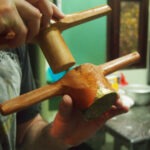This post may contain affiliate links.
An egg hopper is a Sri Lankan food consisting of a special bowl shaped pancake, the hopper, containing a cooked egg. The pancake is made with fermented rice flour and coconut milk, so it has a sour fermented flavour and the sweetness of coconut. Egg hoppers are also known as biththara appa in Sri Lanka’s Sinhala. Plain hoppers are appam. There are many types of hopper in Sri Lanka, including string hoppers (idiyappam) and plain hoppers (the pancakes used in egg hoppers – appam). This post is about egg hoppers, how to make, eat, and serve egg hoppers. Also, what condiments or side dishes should you serve with egg hoppers, and are they served at breakfast, lunch, dinner, or as snacks in Sri Lanka?

Egg Hoppers
Egg hoppers are a Sri Lankan food you really must try! You may find egg hoppers as part of your Sri Lankan breakfast menu, alongside dal, chutneys and fresh Sri Lankan fruits.

You can also find egg hoppers for sale at street food stalls in the cities, villages, and beaches of Sri Lanka, in the early evening as a tea-time snack or treat.

Your hotel in Sri Lanka is quite likely to have egg hoppers on the breakfast buffet menu, but you’re unlikely to find hoppers for lunch or dinner in a restaurant.

A Sri Lankan breakfast with hoppers, egg hoppers, or string hoppers, chutneys and curries, is just as good, if not better, than a full English breakfast. And that is high praise for this Sri Lankan treat.
How To Make Egg Hoppers
It is traditional to make egg hoppers in a small bowl-shaped pan, almost like a mini-wok called an appachatty or appachetty. If you don’t have a pan like this among your kitchen gadgets, you can buy a hopper pan here on Amazon.
Some hopper pans have 2 handles on either side and a lid (like this non-stick version) others have a single handle like a wok. As a Chef, I find a single handle pan much easier to use on a gas flame to work fast and avoid burning myself or the handles!
If you have an Asian grocery store near you, they may stock the original Indian or Sri Lankan hopper pans. These will not be non-stick and will need seasoning.
For home cooking, I prefer a non-stick hopper pan with a single handle. To cook the egg in the egg hopper you will need to cover the pan. We all have plenty of saucepan lids on hand to do this.
The hopper batter used in egg hoppers is very simple, but the batter is fermented using a little yeast and sugar, or palm sugar if you can get this ingredient. This doesn’t make the batter sweet, instead it gives a slight yeasty sourness. The other ingredients in egg hopper batter are coconut milk or cream, water, rice flour and salt. Leave the yeast to do its job overnight or for around 18 hours. This is why Sri Lankan food can’t be hurried. But start a hopper batter the night before, and you will have hoppers for breakfast.
To cook the hopper batter, simply pour a little into your hot, oiled pan, and swirl it to coat the sides, forming the characteristic bowl shape. Once the edges of the crepe or pancake start to come away and look crisp, crack an egg into the base of the pan and continue to cook over medium to low heat until the egg is cooked to your liking.
Cover the hopper pan with a lid to help the egg set from the top down.
Cook the batter until no raw mix remains. Also allow the egg to set to your liking, firm and cooked through or sunny side up. Then slide the egg hopper out onto a plate and enjoy!
Why are egg hoppers called egg hoppers?
Hoppers are Sri Lankan bowl-shaped pancakes. An egg hopper is a hopper, with an egg cooked inside it. String hoppers are different, they’re noodles, nests of steamed batter in long strings. An egg hopper is a rice flour fermented pancake, plus an egg.
You can also find hoppers in India. Look for Appam and Idiappam on menus.
If you'd like to hire a car during your stay, use this car rental comparison tool to find the best deal!
Please check out our Pinterest account for loads of food and recipes from around the world!









